Music is the universal language
“Glory to God in the highest heaven, and on earth peace to those on whom his favor rests.” - Luke 2:14
General Interest
Guitar World deals of the week: save $230 on a Fender Tone Master amp, get more than half off a guitar pedal, plus all the week's best deals
Acoustic Gear Showcase 2025

From cutting-edge pickups to museum-worthy display cases, this Acoustic Gear Showcase is packed with tools to elevate your tone—and your space. Whether you're chasing pristine plugged-in sound, ergonomic performance upgrades, or just a serious vibe boost, these six standouts from Godin, Walden, Mojotone, LAG, and more deliver the goods.
Nashville Guitar Habitat
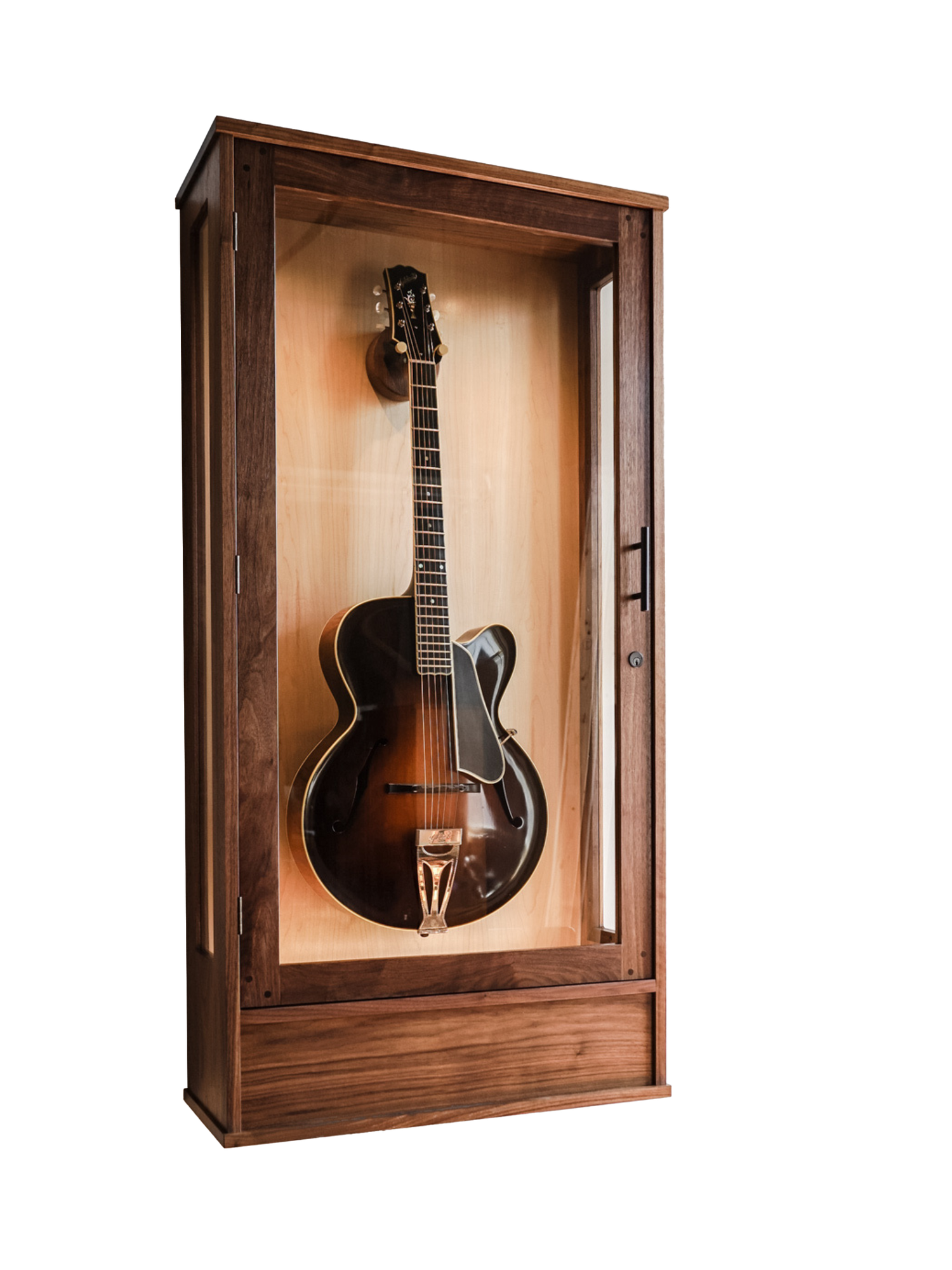
A wall-mounted showcase designed for your most prized instrument. The Nashville safely hangs and displays a variety of guitar bodies in a solid wood and tempered glass case. Includes a locking door, adjustable LED lighting, and your choice of Boveda passive humidification or AMF's 1.5q Active humidification system.
Godin Multiac Nylon Opalburst / Oceanburst
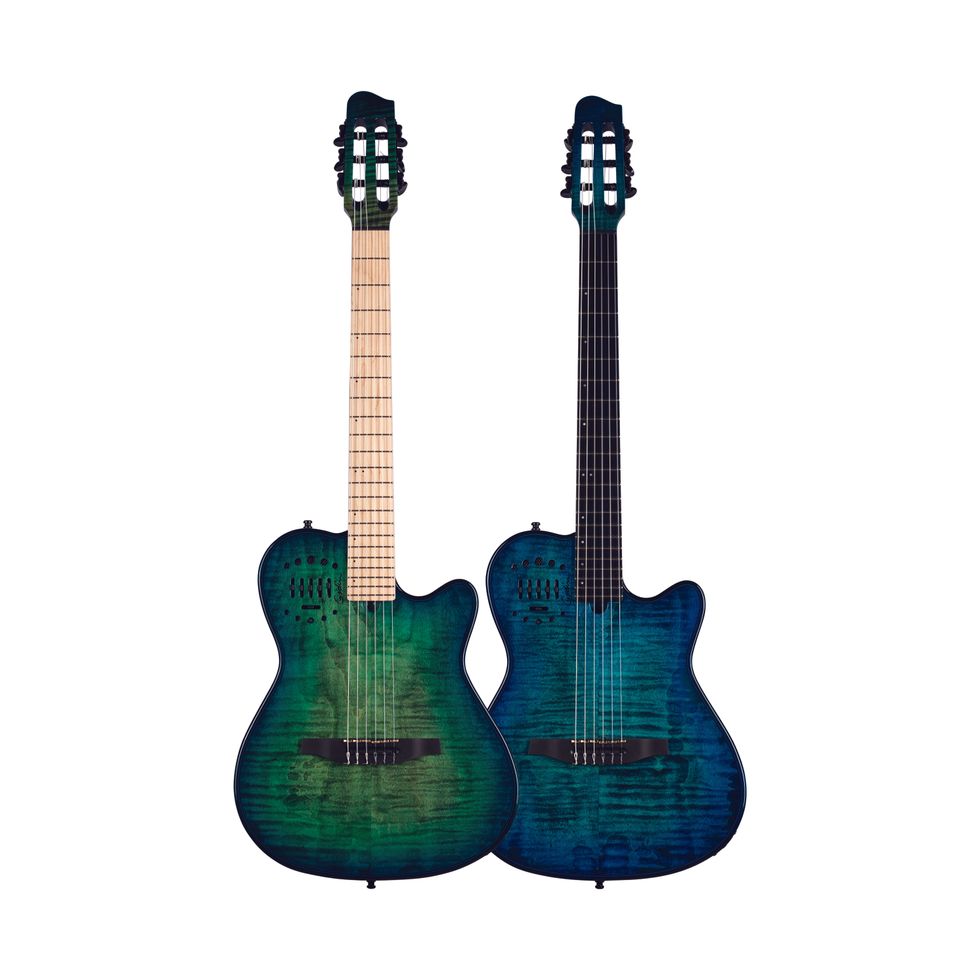
The Godin Multiac Nylon Opal Burst and Ocean Burst, inspired by Godin artists Opal Ocean, feature stunning flame tops and matching headstocks. Made in Canada, they deliver the exceptional tone and playability that have made the Multiac the gold standard for plugged-in nylon-string guitars.
Quiet Coil NC-2 Mic/Blend Acoustic Guitar Soundhole Pickup
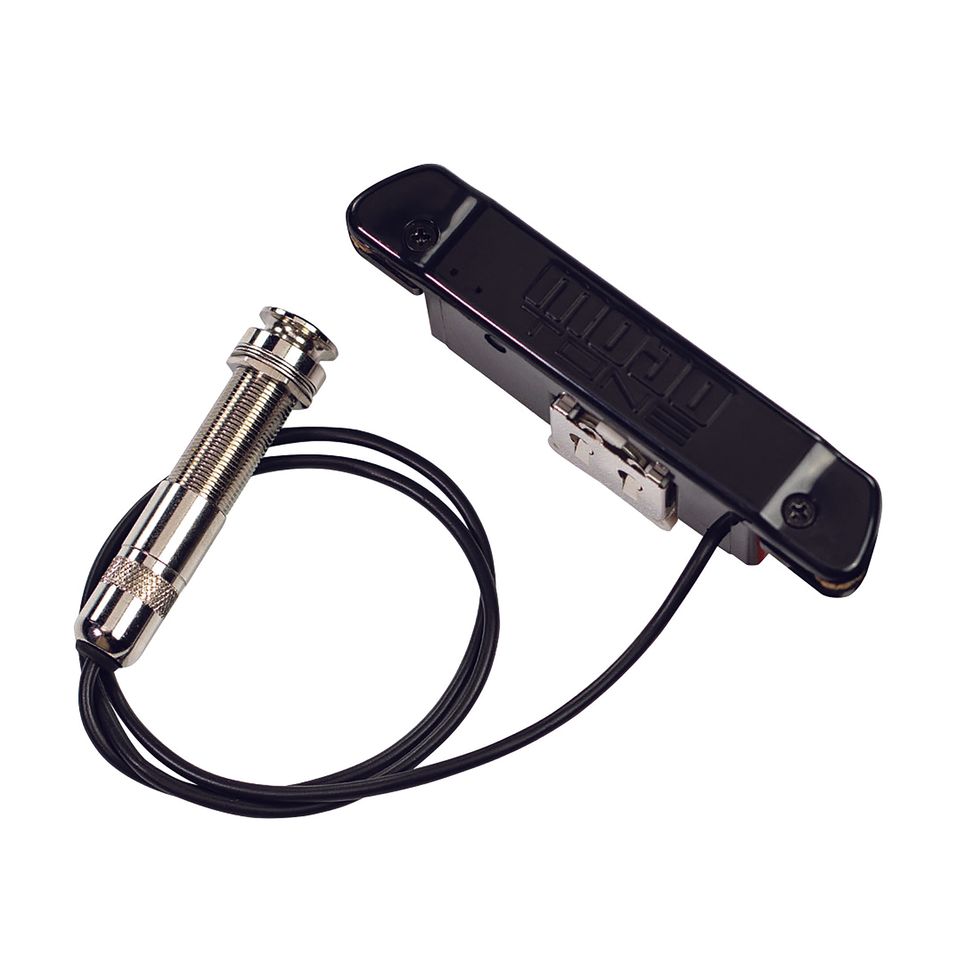
The Mojotone Quiet Coil NC-2 is equipped with new, groundbreaking mic technology that puts this acoustic soundhole pickup into a league of its own when it comes to pure and natural acoustic guitar sound. Our mission was to combine our incredibly natural sounding “mic-voiced” and noise-canceling NC-1 magnetic pickup.
Peter Stroud Signature Slides

Designed by Peter Stroud (Sheryl Crow and Close Enemies) to help create the tones in his head and heart. Peter has been a big fan of RMSC and we are thrilled to be able to offer a real "official" tone tool just for him. It’s made out of FireCracker Aluminum for speed and tone.
HyVibe Series
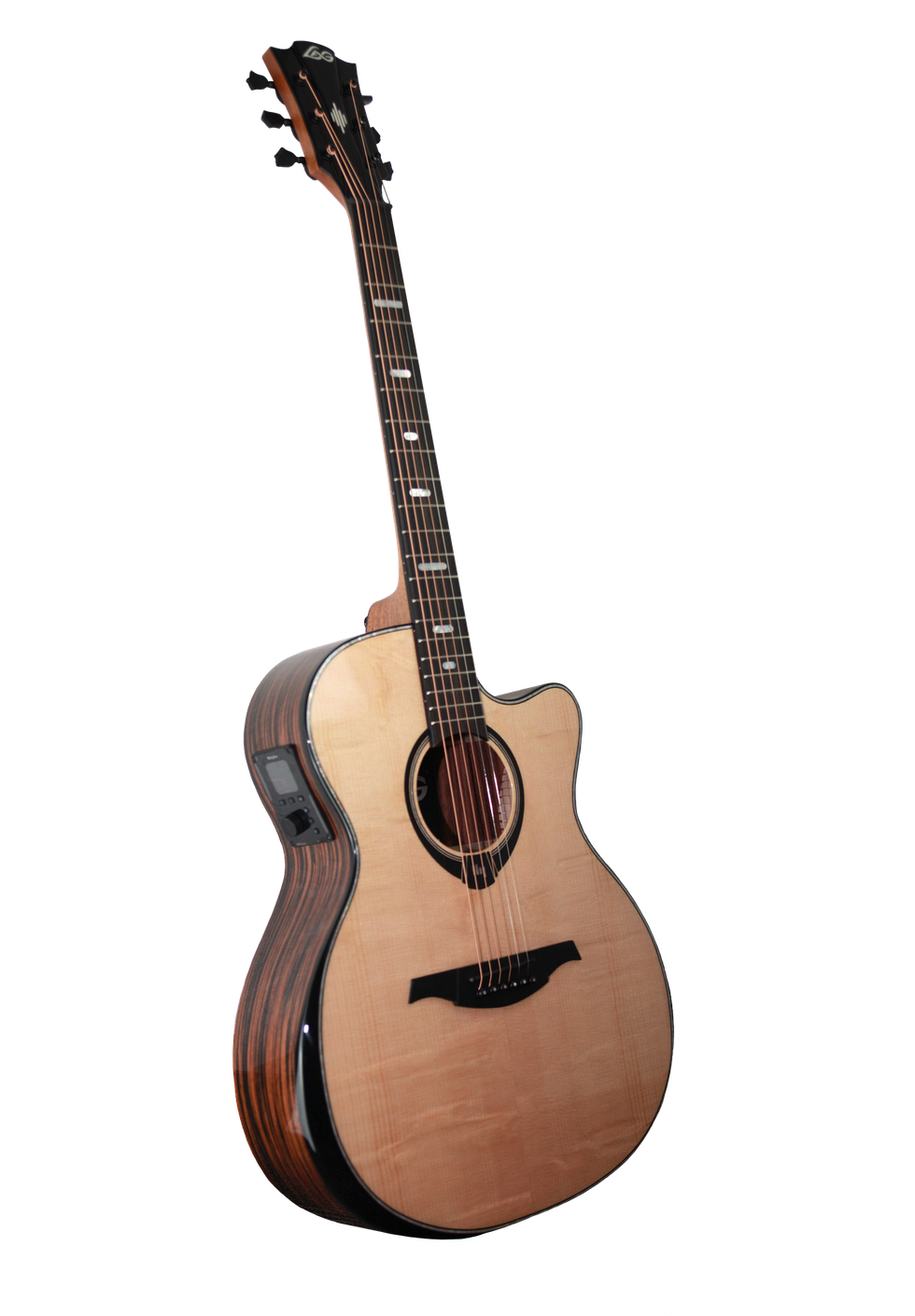
Unlock your creativity! The new LAG HyVibe H2 Series blends craftsmanship with technology, offering built-in effects, looping, and Bluetooth. Pair with the optional HyVibe FS-2 or FS-4 pedal for expanded control of effects and looper functions. No amp required, just pure inspiration.
Walden Natura G633RCE-G
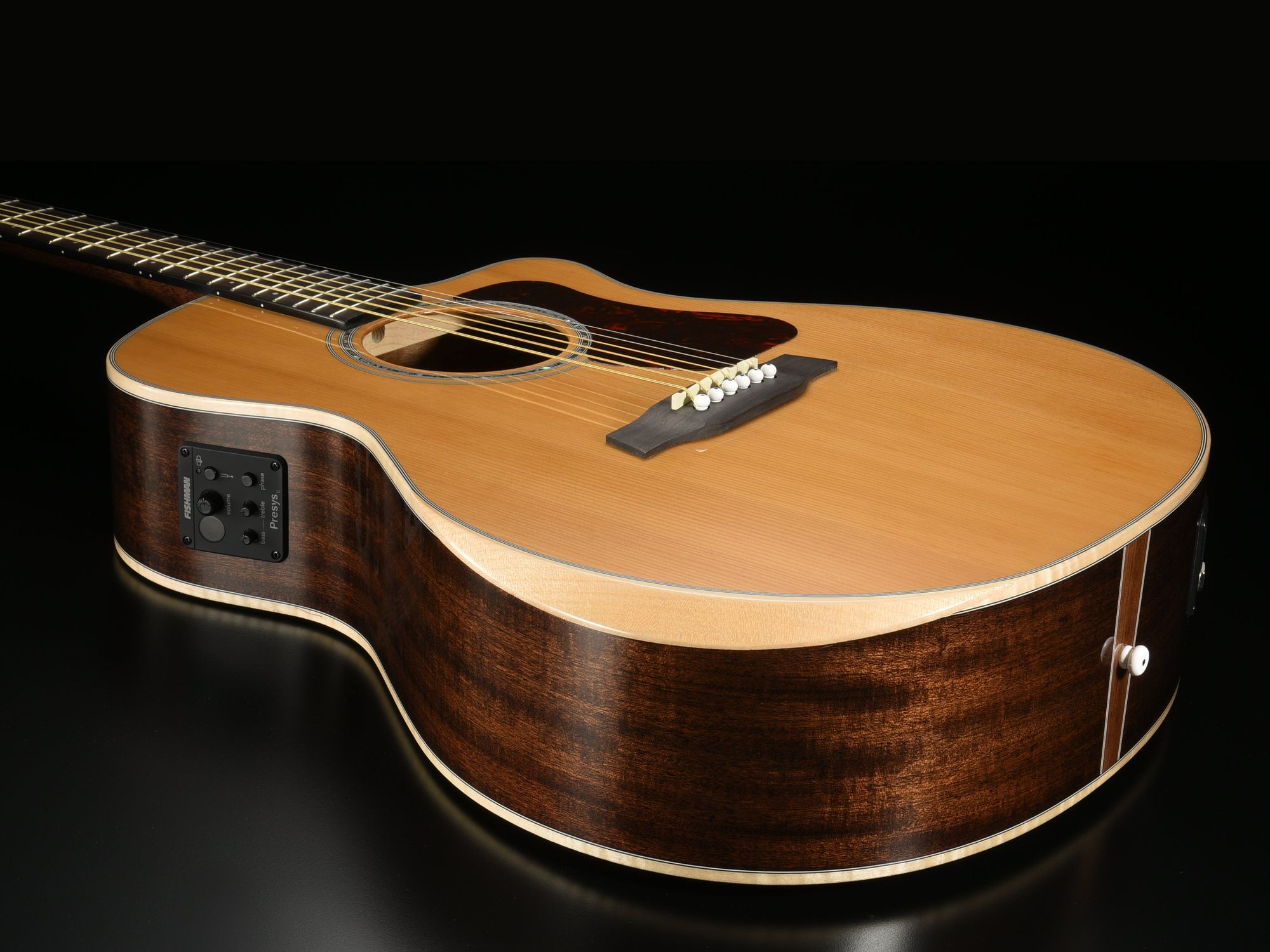
Get the best sound out of every strum with Walden’s low-mass scalloped-X bracing and glass-fibre reinforced neck. This Grand Auditorium cutaway-electric features an ergonomic armrest—usually found on pricier instruments. A warm, resonant solid Cedar soundboard, paired with African Ovangkol, accentuated by a UV-cured gloss finish and offset position markers.
Two world leaders solidify diplomatic relations by delivering their own rendition of an Eric Clapton classic
Join Sean McGowan, Alex de Grassi, and Grant Gordy for an Introduction to ‘The Holistic Guitarist’
“It's best always to just do the same chord and call it different things”: SNL legend Fred Armisen has a signature guitar strap – but there's something not quite right about his guide to chords
“We all have easy access to the parts needed to make a pickup… You certainly don’t have to start like Seymour Duncan did with a record player’s turntable”: Why more guitar builders are making their own pickups
“Rates are coming back up, rents very rarely go down, and suppliers are in straitened circumstances”: Is crowdfunding the answer to ensuring guitar stores’ survival? One family-run business has launched an innovative campaign to keep its stores alive
“I’ve never been one of those guys who will go into a guitar store and play Stairway to Heaven…’” Jim Babjak reveals he once bought a ’70s Les Paul without even trying it – and how it would go on to shape one of The Smithereens' biggest hits
“I have to be careful what I say about Roger or he’ll be sacking me next”: Pete Townshend says he “couldn’t see anything wrong” with Albert Hall gig that caused Zak Starkey’s firing

Unless you’ve been living under a rock, you probably caught wind of The Who’s recent drummer drama: Zak Starkey was fired, briefly reinstated, then fired again for good, all in the span of a few chaotic weeks.
Now, in a new interview with The i Paper, Who guitarist Pete Townshend opens up about the whole saga involving the band’s longtime drummer, offering some candid (and carefully worded) thoughts on working with frontman Roger Daltrey.
“It’s been a mess,” Townshend says. Asked about the Albert Hall incident – where Daltrey publicly called out Starkey mid-show for allegedly overplaying during The Song Is Over – he admits, “I couldn’t see anything wrong. What you see is a band who haven’t played together for a long time. But I think it was probably to do with the sound. I’ve lost my sound man as a result.”
“I think Roger just got lost. Roger’s finding it difficult,” Townshend adds. “I have to be careful what I say about Roger because he gets angry if I say anything about him at all. He’ll be sacking me next. But that’s not to say that he sacked Zak. It’s a decision Roger and I tried to make together, but it kind of got out of hand.”
Pressed on whether it was a difficult decision to let Starkey go, Townshend pauses: “Well, I’ve never been a huge… I didn’t invite him in, right? Roger invited him. And at that time, I don’t know quite why he chose Zak, but Zak is another Keith Moon. He comes with real, real bonuses and real, real difficulties.”
That said, “I will miss Zak terribly,” says the guitarist. “But quite what the story is, I don’t fucking know. I really don’t know.”
As for what’s next, The Who are set to embark on what’s billed as their final tour in August. Though Townshend doesn’t sound entirely sold on that either.
“I don’t know whether I’ve been up for doing anything with The Who since 1973,” he laughs. “But I am looking forward to it. Not because it’s the end, but because I hope that we can continue to explore other things.”
In related news, Zak’s father, legendary Beatles drummer Ringo Starr, has also weighed in on the fallout. According to Starkey, Starr told him [via Rolling Stone]: “I’ve never liked the way that little man runs that band,” in what appears to be a thinly veiled jab at Roger Daltrey.
The post “I have to be careful what I say about Roger or he’ll be sacking me next”: Pete Townshend says he “couldn’t see anything wrong” with Albert Hall gig that caused Zak Starkey’s firing appeared first on Guitar.com | All Things Guitar.
Matt Bellamy’s signature Manson Meta MBM-2H returns in Red Sparkle, adds Satin Olive Green and new hardware options

[Editor’s Note: Meng Ru Kuok, Founder & CEO of Caldecott Music Group is a part owner of Manson Guitar Works. Guitar.com is part of Caldecott Music Group]
Fans of Muse frontman Matt Bellamy’s signature guitars are in luck: Manson Guitar Works and Cort have expanded the Meta Series MBM-2H range with fresh colourways, left-handed options and new hardware finishes.
Leading the 2025/26 updates is the return of the much-requested MBC-1 Red Sparkle finish, a glittering, high-gloss lacquer that pays homage to the iconic “Santa” guitars used extensively by Bellamy on stage and in the studio.
The release is available in two formats: a twin-humbucker version featuring Manson-designed pickups for powerful, versatile tones, as well as a Sustainiac-equipped variant for you to dial in infinite sustain.
In the Sustainiac model, the neck humbucker is swapped out for the same pickup system Bellamy uses in his instruments. The pickup can be switched to work as an active and detailed regular neck pickup or switched into Sustain mode where three alternative Sustainiac modes are available, each offering endless sustain.
 Credit: Manson Guitar Works
Credit: Manson Guitar Works
Joining Red Sparkle is a brand-new Satin Olive Green finish, also available in both humbucker and Sustainiac-equipped versions. The new colourway is paired with black hardware – a first for the series – adding a stealthy, more aggressive look to the instrument.
Left-handed players can finally get in on the action as well. For the first time, the Meta Series MBM-2H will be available in southpaw versions (no extra charge required), so Bellamy fans of all stripes can get their hands on the celebrated instrument.
As with previous iterations, the Meta Series MBM-2H continues to deliver premium features including a sleek compound radius neck, a kill-button for stutter effects, and Manson’s signature design and playability – all at a remarkably accessible price point.
The MBM-2H is priced at £569, while the MBM-2H-Sustainiac will cost you £899. Both are available now via Cort and Manson dealers worldwide.
Learn more at Manson Guitar Works.
The post Matt Bellamy’s signature Manson Meta MBM-2H returns in Red Sparkle, adds Satin Olive Green and new hardware options appeared first on Guitar.com | All Things Guitar.
“It’s atried-and-true sound that we’ve heard inthe soloing of all of our favorite players, from Jimi Hendrix, Johnny Winter and Leslie West to Eddie Van Halen”: Jared James Nichols explains why we should all be using the blue note in our solos
Fender Acoustasonic Standard Telecaster review: “these are sounds you don’t hear in a live context very often”

$629/£569, fender.com
At this point, you probably already know how you feel about the Fender Acoustasonic phenomenon. Since Fender’s hybrid acoustic-electric arrived in 2019, it’s probably been the most polarising concept the world’s biggest guitar brand has foisted on the guitar-buying public since the Katana.
- READ MORE: Taylor 314ce Studio review: “Forget where the neck is made, this is every bit the US-made instrument
In truth though, a lot of opprobrium that the Acoustasonic has inspired in the last half a decade has primarily been down to how it looks. For a not-insignificant proportion of the guitar-buying public, sticking a soundhole in the middle of a Tele is akin to doodling a toothbrush moustache on the Mona Lisa.
And if that is you, I’m sorry but this review is unlikely to either change your mind, or indeed confirm your preexisting negative feelings. Because despite being a little unconvinced by the concept when it was unveiled at NAMM back in January 2019, any misgivings I had about the aesthetics were soon sidelined by the experience of using one in practice.
It might not be the perfect middle-ground between acoustic and electric guitar that Fender’s most feverish press releases may claim, but as a guitar that can provide decent electric and acoustic sounds in a live or home environment, it’s pretty bloody effective.
What’s also been impressive over the last few years is that despite the online grumbling, Fender clearly believes in this concept. Not only has the concept been expanded to include both Jazzmaster and Strat body shapes, but it’s also made its way down the pyramid, with the Mexico-made Player versions being hugely impressive when I checked one out a few years back. It’s also correlated with seeing a fair few more of these guitars in the wild being used as they were intended. Unsurprisingly the more you drop the barrier of entry, the more likely people are to take a chance on something unusual – so what if they dropped that bar even lower?
 Image: Adam Gasson
Image: Adam Gasson
Fender Standard Acoustasonic Telecaster – what is it?
You’ll have noticed that the ‘Standard’ designator has been revived by FMIC in 2025 to denote its latest attempt to blend Asian manufacture and prices with the Fender brand. Previously, this was only the outlet for leftfield Fender releases like the Starcaster or the Modern Player series, the gradual inflation of Fender’s Mexico range meant that there was a gap in the market that was filled with a new series of classic designs made by Cor-Tek in Indonesia.
The results of that were a mixture of ‘pretty good’ and ‘fine’, so the decision to add a pair of Acoustasonic guitars to that range did have me wincing a little. A bolt-on solidbody electric guitar is a damn sight easier to mass-produce than a hollowbody hybrid, and I’ve heard a few eyebrow-raising QC horror stories with the Mexico-made Player versions – would this be a bridge too far?
And what about that price? At less than $600 it’s basically half the price of the Player version. That can’t be entirely down to the reduced cost of Asian manufacturer – compromises will have to be made somewhere.
 Image: Adam Gasson
Image: Adam Gasson
For starters, the body wood is not mahogany anymore, but nyatoh – a popular and common substitute for mahogany on budget guitars. As with the Standard Telecaster, the three-piece back isn’t the most artfully matched, and the grain patterns are distinct enough that they barely look like the same species of wood, let alone the same tree. But honestly, we’re dealing with a $600 guitar here, what else do you expect? Conversely, the top is actually quite a nice bit of solid Sitka spruce, considering – the grain is straight and pretty even, with some subtle figure that I think looks pretty good.
It’s an effect helped by the thinly-applied Aged Natural finish – it’s the most unadorned of the three options at launch, but I think it’s perhaps the best. The finish is nicely applied, letting you feel the texture of the wood under your fingertips, without being so delicate that fingerprints or scuffs feel like a pressing concern.
Another big change can be found under the hood – whereas the Player Acoustasonic paired an undersaddle piezo with a Noiseless single-coil pickup, here we have a new Shawbucker humbucker in the bridge position.
The electronics themselves have also been streamlined – gone is the pickup selector switch, replaced with a master blend switch that allows you to choose exactly how much of each pickup you want at any given time.
 Image: Adam Gasson
Image: Adam Gasson
Fender Standard Acoustasonic Telecaster – build quality
Despite some of the material differences, and that huge price drop, I was pleasantly surprised with how this guitar played and felt out of the box. Body still feels nicely ergonomic in a way that a regular Tele isn’t, and the overall fit and finish of the purfling, joining and general build feels impressively solid.
The neck is a pleasingly chunky ‘Modern Deep C’ in Fender’s parlance, with a 12mm radius and 22 frets. In practice, that makes for a slightly chunkier feel than the regular Standard guitars, but still more than slinky enough for easy playing – in truth I wish they put this neck on the regular guitars. The enjoyable playing experience is further enhanced by Fender’s latest trick – rolling fingerboard edges. It’s subtle again here, but it really does make the playing experience feel more worn-in and enjoyable.
In truth, a lot of the differences between the Player and Standard Acoustasonics can be found in the neck, and not all of them are great. Gone is the lovely routed Fender logo on the Tele peghead, replaced with a slightly cheap looking mirrored affair, but the other end is more jarring.
A feature of Acoustasonics past has been a chamfered neck heel allowing easier access to the upper frets. Here however we have a standard chunky Tele-style four-bolt square heel with blank silver plate. It’s only a big deal if you are planning to spend a lot of time up the top end of the neck, and you could argue that the standard Tele arrangement hasn’t done much to put players off that. Still, it’s something that I missed when picking it up for the first time.
 Image: Adam Gasson
Image: Adam Gasson
Fender Standard Acoustasonic Telecaster – build quality
When the Acoustasonic first launched it had all sorts of fancy sonic options under the hood – including various modelled acoustic sounds to choose from and blend them accordingly. It was a bit much, in all honesty, and it was no surprise to see the Player version simplify things a great deal. Here however, we’re stripping things back even further – with none of that modelling stuff at all, and not even a pickup selector to work with.
All the control is based around that blend knob – at one end it’s all piezo, at the other it’s all electric, and you can find your happy place somewhere in between. The only other control is a volume knob, which feels somewhat superfluous in this context, you have to say. It’s a somewhat frustrating layout, to be honest – the ability to switch between all-electric and all-acoustic at the flick of a selector switch was useful on the Player version, and sweeping a knob is nowhere near as immediate.
Mercifully, Fender abandoned the endlessly annoying built-in rechargeable battery of the American version long ago and as with the Player here you power the whole thing with a 9V battery accessed by a hatch in the back of the rear control cavity.
 Image: Adam Gasson
Image: Adam Gasson
Fender Standard Acoustasonic Telecaster – sounds
In my review of the Acoustasonic Player Jazzmaster, I extolled the virtue of the guitar as the ultimate couch guitar – after all, it has the easy playability of an electric with the tonality of an acoustic, and the family-friendly volume of a semi.
It’s unlikely that anyone is buying an Acoustasonic purely to play on the sofa, but I’d be surprised if it hadn’t ended up in that role in a lot of homes that own one. That being said, the Standard continues the Acoustasonic’s impressive track record of sounding much bigger and fuller than its body shape should allow. It’s perhaps not as loud as the Jazzmaster I tested a few years ago, but the Stringed Instrument Resonance System (aka the soundhole) once again does an impressive job of making it sound like an acoustic, but just quieter.
Plugging in, and with no digital ‘images’ (Fishman’s term for models that aim to mix the mic’d sound of an acoustic with the piezo) colouring the tone here, the onus really is on that undersaddle transducer to sound decent, and mercifully it does – with a surprising amount of bottom-end and minimal piezo honk. It’s not going to go toe-to-toe with pickup systems that cost more than this guitar of course, but it sounds better than most entry-level pickup systems despite its diminutive size.
What is a little disappointing is what happens when you plug it into an electric amp. It’s perhaps not surprising that an acoustic pickup loses some of the pizazz when plugged into an amp set up for raucous electric guitar… but there is the small matter of that honkin’ great humbucker in the bridge. It seems weird to me that you wouldn’t try to voice the pickup to sound better with an electric amp given its stated purpose. Maybe the thinking is that you’ll always have an ABY switch or a modelling solution to cater to each sound… but it just seems weird to me.
The Shawbucker itself is punchy and fun, in a polite kinda way – this is a humbucker on an acoustic guitar don’t forget so expecting it to soak up endless lashings of gain is perhaps unrealistic. As with the other Acoustasonics, the sweet spot really is found in the blending – it adds real depth and presence to your sound that occupies neither the fully electric or fully acoustic world. This feeling is enhanced with the addition of some subtle time-based effects – these are genuinely sounds you don’t hear in a live context very often, and they’re hugely compelling in practice.
 Image: Adam Gasson
Image: Adam Gasson
Fender Standard Acoustasonic Telecaster – should I buy one?
The more prescient question is probably, ‘Have you ever been intrigued by an Acoustasonic before?’ Because if the answer is any kind of yes, you no longer have any excuse not to dip your toe in and see what the fuss is about. I would never accuse a giant multinational corporation of having anything so human as ‘guts’, but it has taken a lot of organisational fortitude for Fender to ignore the naysayers and persist with the Acoustasonic programme for over half a decade now. And to gradually make it more and more accessible along the way. The Standard is probably the final word in that direction (it’s hard to see what else could be trimmed to make a Squier version), and it’s a definitive one. Try it.
Fender Standard Acoustasonic Telecaster – alternatives
A lot of the thinline acoustic guitars out there are more classical crossovers, which I think is a different ballgame entirely, and so many of the Standard’s rivals are found in Fender’s own stable. You have the Acoustasonic Player Telecaster ($1,199/£1,029), of course, but also if you want your guitar to be more acoustic-shaped the Highway Parlor ($999/£819) is a stage-ready option. If you want a small, stage-ready acoustic with no sonic compromises, LR Baggs’ AEG-1 ($1599/£2,099) is hugely impressive – but it’s acoustic only.
The post Fender Acoustasonic Standard Telecaster review: “these are sounds you don’t hear in a live context very often” appeared first on Guitar.com | All Things Guitar.
“Keith didn't want anything to do with it. He hated my records”: Dann Huff and Keith Urban got off to a rocky start – but they went on to create a string of number 1 singles together
Geezer Butler has “given up talking about the end of Sabbath”: “Every time I think it’s over, things like this show come along”

Black Sabbath’s final reunion show may be set in stone, but Geezer Butler isn’t ready to rule anything out just yet.
After countless shows, lineup changes, a farewell tour dubbed The End, and more “final” moments than most bands have riffs, Black Sabbath are gearing to bow out – supposedly for real this time.
The heavy metal pioneers will reunite on 5 July at Villa Park in Birmingham for what’s being billed as their last-ever performance. The one-day extravaganza, headlined by Sabbath, and preceded by Ozzy Osbourne’s own mini set, is supported by heavy hitters like Metallica, Pantera, Slayer, Gojira and more.
All four original members – Ozzy, Butler, Tony Iommi, and Bill Ward – have spoken publicly about the occasion, though not all are equally convinced it’s the end.
Iommi, for one, is done. “I won’t be doing it again,” he tells MOJO. “This will be the final show. I mean, can you imagine us trying to tour? No, this will be it.”
Ward, meanwhile, chuckles when prompted on Osbourne’s repeated promises to call it quits. “He says a lot of stuff,” the drummer reasons. “But the gist of it was, ‘I’m gonna do one last time.’”
Then there’s Geezer Butler, who shares in the same interview that he’s “given up talking about the end of Sabbath.”
“Every time I think or say it’s over, things like this show come along,” he says. “Someone will probably have our DNA and resurrect us in the distant future… Who knows?”
In Ozzy’s case, that may not be entirely hypothetical. The frontman recently partnered with canned water company Liquid Death on a limited run of iced tea cans supposedly infused with his actual DNA.
At 76 and amid significant health challenges – including Parkinson’s and spinal injuries – Osbourne has kept his role at the upcoming show modest. The Prince of Darkness previously revealed that he’s “not planning on doing a set”, even though he has been working out in preparation for the big night.
To be fair, Sabbath have ‘ended’ before. Their last farewell tour wrapped in 2017, also with a final performance in their hometown of Birmingham. But here they are again, plugging back in for one more glorious send-off. And as Butler reminds us, with Sabbath, you never really know.
The post Geezer Butler has “given up talking about the end of Sabbath”: “Every time I think it’s over, things like this show come along” appeared first on Guitar.com | All Things Guitar.
“His strength and resilience remain unwavering”: Hatebreed guitarist diagnosed with benign brain tumour after Download Festival appearance

Hatebreed guitarist Wayne Lozinak has been diagnosed with a non-cancerous brain tumour following the band’s recent appearance at Download Festival.
According to a statement shared by the band, Lozinak began experiencing “mild symptoms that raised concerns of a possible stroke” on the night of 14 June while at Download Festival. When the band travelled to Lille, France the following day, Lozinak sought medical attention out of an “abundance of caution”.
A CT scan performed at a local ER revealed a brain tumour, prompting immediate hospital admission for further testing. After a 24-hour evaluation, including an MRI, doctors identified the mass as a benign meningioma – a slow-growing tumour that has “likely been present for years.”
“We are immensely relieved that Wayne’s diagnosis is the best possible outcome given the circumstances,” says the band. For now, Lozinak will be returning to the United States to prepare for surgery and focus on his recovery.
In the meantime, Hatebreed will continue their European and UK dates as planned, with touring bassist Matt Bachand stepping in on guitar, and Carl Schwartz of First Blood and Terror joining the group on bass duties.
The group closed their announcement with gratitude to fans, friends, and the wider music community for their support during this time. Lozinak, who has been a key part of Hatebreed’s hard-hitting sound since rejoining the band in 2009, is reportedly eager to return to the stage “as soon as he is able”.
Hatebreed’s UK and European tour is set to wrap up with a London show on 6 July, after which the band will head straight back to the US to headline the Summer Slaughter Tour, beginning 8 July in St. Petersburg, Florida.
Check out the full list of tour dates and get your tickets at Hatebreed.com.
The post “His strength and resilience remain unwavering”: Hatebreed guitarist diagnosed with benign brain tumour after Download Festival appearance appeared first on Guitar.com | All Things Guitar.
“You are always part of a team, not a solo artist at all”: Why Carol Kaye has declined her Rock and Roll Hall of Fame induction invitation

Carol Kaye, session veteran and one of the most prolific bassists of all time, is the latest musician to turn down the Rock and Roll Hall of Fame’s invitation this fall.
Kaye, who’s set to be inducted as part of the Hall’s Class of 2025, says she won’t be attending the ceremony because it “wasn’t something that reflects the work that studio musicians do and did in the golden era of the 1960s recording hits.”
The 90-year-old, estimated to have played on over 10,000 recording sessions, including works by the Beach Boys, Simon & Garfunkel and Frank Zappa, was part of a group of session musicians known as the Wrecking Crew during the Sixties and Seventies.
“People have been asking: NO I won’t be there,” Kaye writes of her decision in a now-deleted Facebook post. “I am declining the rrhof awards show and Denny Tedesco process [director of the 2008 documentary The Wrecking Crew]”.
Underlining the collaborative nature of studio musicians, the bassist explains, “You are always part of a team, not a solo artist at all. There were always 350-400 studio musicians (AFM Local 47 Hollywood) working in the busy 1960s, and called that only. Since the 1930s, I was never a ‘Wrecker’ at all…. that’s a terrible insulting name.”
Kaye also clarifies that she found her way to the bass not by choice, but by chance.
“Just so you know, as a working Jazz musician (soloing jazz guitar work) in the 1950s working since 1949, I was accidentally asked to record records by producer Bumps Blackwell in 1957, got into recording good music, with Sam Cooke, other artists and then accidentally placed on Fender Precision Bass mid 1963 when someone didn’t show.”
“I never played bass in my life,” she continues. “But being an experienced recording guitarist, it was plain to see that 3 bass players hired to play ‘dum-de-dum’ on record dates, wasn’t getting it…..it was easy for me to invent good bass lines…..as a Jazz musician, you invent every note you play……and they used a lot of Jazz musicians (and former big-band experienced musicians on all those rock and pop dates too).”
Kaye ends her note by declaring: “I refuse to be part of a process that is something else rather than what I believe in, for others’ benefit and not reflecting on the truth – we all enjoyed working with EACH OTHER.”
Carol joins a growing list of musicians who’ve taken issue with the Rock Hall’s decisions and supposed credibility.
Duran Duran bassist John Taylor previously called their own induction a farce, saying, “It’s such a joke that Duran Duran are in anything with ‘rock and roll’ over the top of it.”
Liam Gallagher was even less diplomatic when Oasis was nominated in 2024. “Fuck the Rock and Roll Hall of Fame – it’s full of bumbaclarts,” he posted on X. When a fan urged fellow supporters to vote, Gallagher replied, “Don’t waste your time… it’s all a load of bollox.”
Or as he put it most succinctly, “I don’t need some wank award by some geriatric in a cowboy hat.”
The post “You are always part of a team, not a solo artist at all”: Why Carol Kaye has declined her Rock and Roll Hall of Fame induction invitation appeared first on Guitar.com | All Things Guitar.
The Rig Rundown Rig Rundown!
I've been lucky to serve as host, producer, and editor of the Rig Rundown for Premier Guitar for over a decade, and in this video, we'll walk through the cameras and audio gear we're currently using to bring you in-depth looks at your favorite artists' rigs. You'll see how Chris Kies and I have evolved our video and audio setup over the years and how a recent chance encounter led to a major upgrade with help and advice from our friends at Sweetwater.
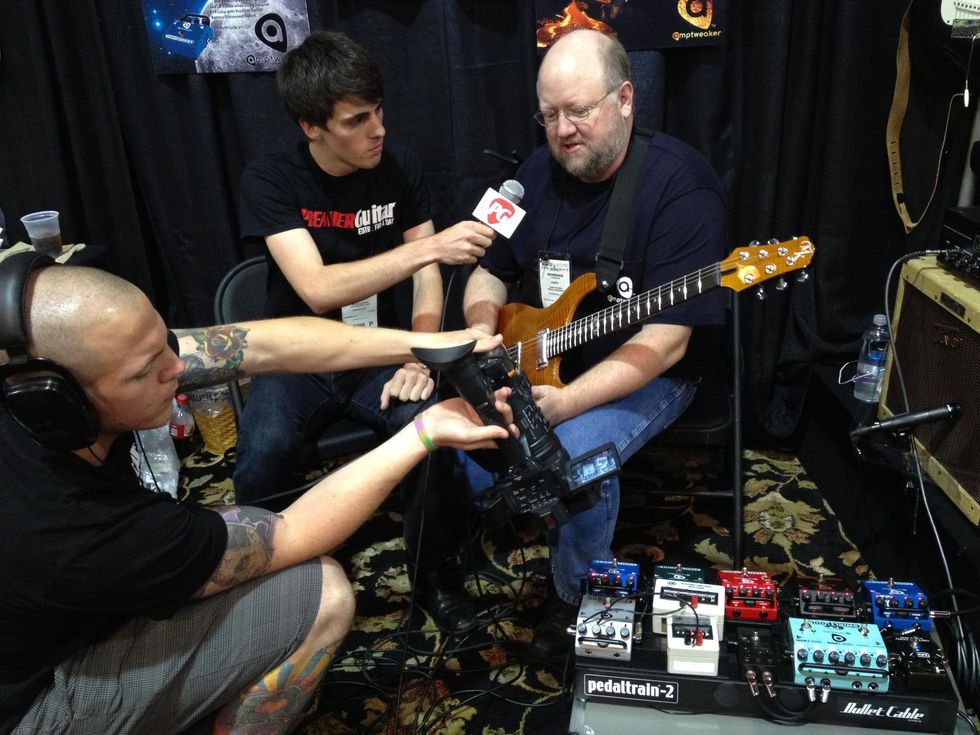
Rig Rundown cameras and microphones have had many iterations since the series launched in 2007
Rig Rundown Gear Through The Years

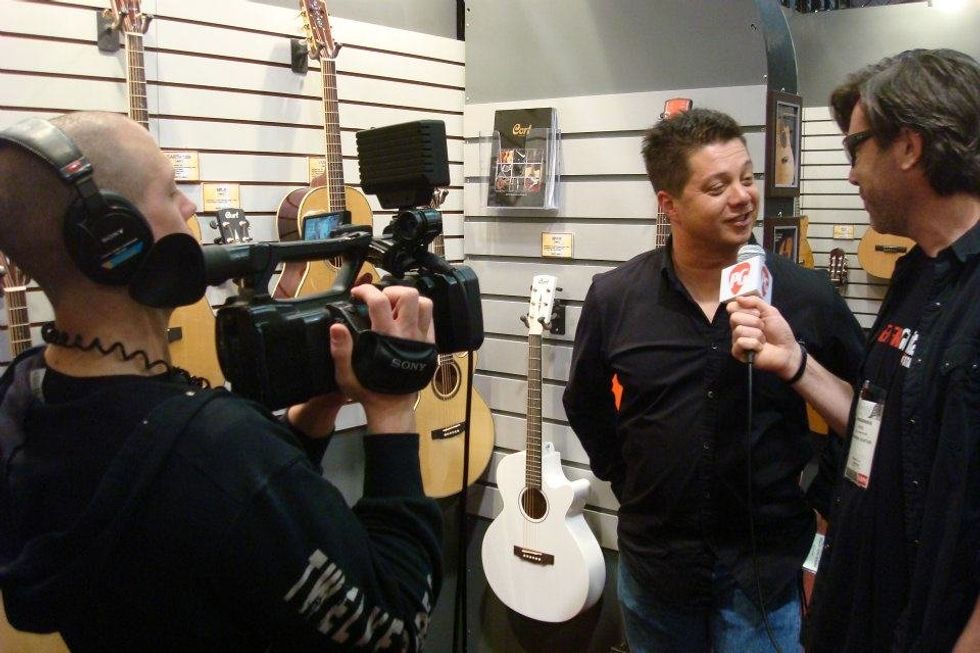
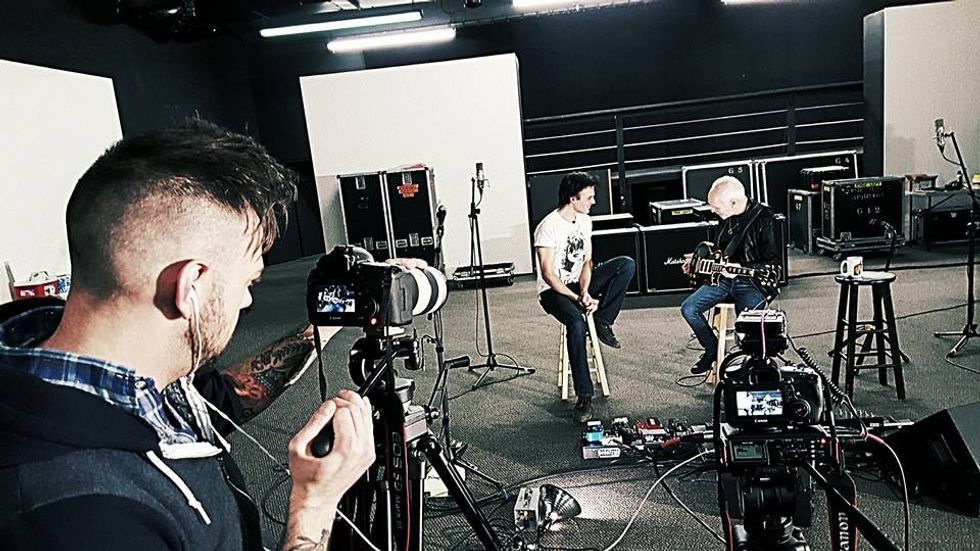
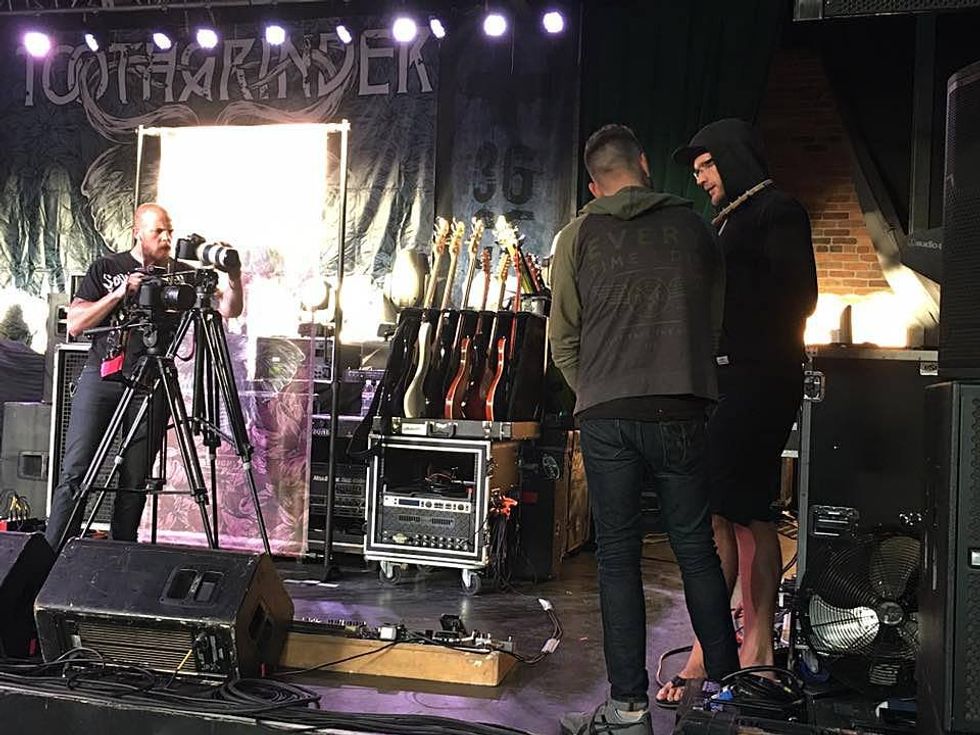
Blackmagic Design Pocket Cinema Camera 6K Pro (Body Only)
Pocket Cinema Camera 6K Pro
The Pocket Cinema Camera 6K Pro offers the robust video, audio, and connectivity of Blackmagic’s Pocket Cinema 6KG2 camera but with some added features geared toward professionals. With sky-high UHD definition, the Pocket Cinema Camera 6K Pro is easily one of the most powerful compact videography tools sold today! The camera itself is solid, light, and easy to manage during extended shoots. A high-strength carbon composite body reinforced with carbon fibers gives the body rigidity and shock resistance without adding bulk, so you can safely take it anywhere without fear. A full-size Super 35 HDR sensor captures 6K images at up to 60 fps, while a 5-inch tilting touchscreen with touch focus tools and advanced overlay monitoring handles controls and monitoring. The 6K Pro’s screen also features an enhanced 1500-nit display that performs better in harsh light than other Pocket Cinema cameras. The Pro model offers switchable ND filters for bright daytime shoots with clear, 2, 4, and 6-stop options. Low light performance is equally stunning with enhanced dual native ISO with 13 stops and a massive 25,600 ISO ceiling to ensure clarity with minimal noise. And when it comes to audio, this camera is practically a full mobile studio with four built-in mics and plenty of additional inputs for external mics via 3.5mm and mini-XLR connectors. Optimized for demanding professionals, both aspiring and established, this is a truly expansive high-end camera that delivers high-quality footage anytime, anywhere.
Blackmagic Design Pocket Cinema Camera 6K Pro Features:
- Premium Super 35 sensor (23.10mm x 12.99m) with stunning 6144 x 3456 native resolution
- Wide selection of frame rate and definition options, including 6K 60 fps and 2.8K 120 fps
- Dual native ISO with 13 stops and massive 25,600 ISO ceiling — incredible range with excellent low-light performance!
- Multifunction grip with quick access to recording, still photos, ISO, shutter, aperture, white balance, power, and more
- Enhanced 5-inch touchscreen with tilt, touch focus, and premium 1500-nit brightness for outdoor shoots
- 4 infrared ND filter options for navigating difficult lighting (clear, 2-,4,-, and 6-stop)
- Compatible with active Canon EF lenses (sold separately) with additional grip controls and automatic metadata population on supported lenses
- 21.2MP still image shooting, saved as fully uncompressed DNG frames — perfect for making professional prints!
- Built-in SD UHS-II and CFast card slots
- USB-C Expansion Port — record straight to an external disk like a hard drive or flash drive
- Full-size HDMI output for monitoring
- Built-in speaker for field playback
- 4 built-in microphones, 3.5mm stereo jack, 3.5mm headphone jack, and 2 mini XLR audio inputs with phantom power and line level +14dBu options
- Built-in timecode generator for streamlined multi-cam shoots
- Full Bluetooth camera control with 30-foot wireless range
- Accessory kit includes camera strap, 30W power supply with international adapters, lens turret dust cap, battery, charger, and DaVinci Resolve Studio activation key
- 12-month limited manufacturer warranty from Blackmagic Design
Kondor Blue Blackmagic Pocket 6K Pro Base Rig - Black
Pocket 6K Pro Base Rig (Black)
Maximize the potential of your Blackmagic Pocket Cinema Camera 6K with the Pocket 6K Pro Base Rig from Kondor Blue. Complete with a BMPCC 6K Pro Cage with a top handle, an ARRI bridge plate, included PPSH rods, and an EF Cine CAP, you'll have more than enough possibilities to build the perfect rig for your camera. The top plate and side plates both feature NATO railing for exclusive accessory options. Likewise, built-in HDMI and USB-C cable clamps facilitate a tangle-free setup when dealing with external gear. Sweetwater cinematographers specifically appreciate the rig's built-in grip design, which keeps long-term filming sessions comfortable and steady in any environment. Whether you're looking to build up an entirely new rig or integrate your device into a pre-existing setup, the Pocket 6K Pro Base Rig from Kondor Blue is an opportunity that can't be passed up.
SanDisk Professional Pro-Blade 2TB SSD MAG
Pro-Blade, 2TB, SSD MAG, NvME, Ultra Portable
Kondor Blue Pro-Blade SSD Handle
Pro Blade SSD Handle
The entrusted Pro-Blade SSD system meets versatile videography with this top mount from Kondor Blue. Compatible with several modern camera models, the Pro-Blade SSD handle provides a simple solution to mobile storage space. Sweetwater videographers have found that the handle’s versatile mounting system allows it to be used as either a top or side handle, depending on your filming situation. Additionally, an onboard cold shoe, safety stop, 1/4-inch-20 ARRI-style mount, and NATO rails ensure solid integration into your rig of choice. Complete with a protected USB-C connection cable, there’s no better way to haul video storage when you’re on the go.
With Pro-Blade SSD mags, storage has never been simpler. When used with compatible Pro-Blade Transport and Station units, you’ll be able to pop in 1TB to 4TB of storage into any connected device. At only 0.10 pounds, you’ll be able to carry a bundle of mags with you when you’re on the go, providing endless storage opportunities at any time. Sweetwater photographers and videographers are always on the move, and the Pro-Blade storage system has proven to be quite the lifesaver.
Shure ADX5D Axient Digital Dual-channel Portable Wireless Receiver
Axient Wls Dual-Ch RCV
When you need maximum wireless performance and reliability — we're talking televised live performances, secure government installations, and similar mission-critical applications — you need Shure's Axient wireless technology. The Shure ADX5D Axient Digital Dual-channel portable wireless receiver delivers the top-tier reliability and spectral efficiency that have made Axient wireless a leading solution around the world. Thanks to its slot-in receiver form factor, the ADX5D can be configured for direct connection to professional video cameras, or equipped with a battery sled for truly portable operation. And with Frequency Diversity mode enabled, your Shure ADX5D Axient Digital wireless receiver shrugs off RF interference that can cause audio interruptions in less sophisticated systems.
• Next-gen digital radio for maximum stability
• 184MHz tuning range across all receivers and transmitters
• Up to 47 active transmitters per 6MHz TV channel
• Frequency Diversity plus advanced interference detection and avoidance
Shure ADX1 Wireless Bodypack Transmitter with TA4 Connector
Axient Wls Beltpack TXM
Shure WL185m Cardioid Lavalier Microphone with TA4F Connector - Black
Card Lav Mic w/Shure TA4F, Black
As part of Shure's Axient Digital wireless series, the ADX1 wireless bodypack transmitter packs industry-leading digital wireless technology into a compact bodypack solution. All ADX transmitters push the limits of wireless to offer up to 184MHz tuning range, interference protection, advanced recharging options, and wireless control via ShowLink. And the ADX1's advanced control menu offers comprehensive access to all transmitter parameters. To get the most out of your Axient wireless system, Sweetwater recommends the Shure ADX1 wireless bodypack transmitter.
- Wireless bodypack transmitter for Axient digital wireless systems
- TA4 connector
- Advanced control menu for access to all parameters
- Compatible with ShowLink for remote control capabilities
- Durable, moisture-resistant construction
- Up to 10 hours of operation with SB910 rechargeable batteries
- Includes detachable belt clip, threaded TA4F adapter, zipper bag, and detachable antenna
With the WL185m, you’re setting yourself up for sonic success. This lavalier microphone delivers professional sound in a more compact chassis than ever. Compared to the standard WL185, this microphone’s body measures 8mm shorter in length, which helps it blend in and disappear onstage and on camera. Shure tells Sweetwater that the new WL185m includes other improvements, such as greater SPL handling, lower self-noise, and upgraded sound quality. Meanwhile, the cardioid polar pattern helps focus on the wearer’s voice and prevents off-axis noise from entering the signal. Finally, your new WL185m lavalier microphone includes a redesigned tie clip, which offers a rotatable design for improved positioning. Tailor-made for presenters, the Shure WL185m lavalier microphone captures natural, lifelike tones every time.
Shure ADX5-Mount Mounting Plate with Cold Shoe for ADX5D
ADX5D Mounting Plate
Attach the Shure ADX5-Mount mounting plate to your ADX5 wireless receiver, and you're ready to mount it directly to the cold shoe on your camera (or tripod, light stand, or other cold shoe). Mounting directly to your camera is the most convenient and efficient way to manage your wireless receiver, and for that, Sweetwater recommends the Shure ADX5-Mount mounting plate.
Shure ADX5BP-TA3 Dual TA3 Back Plate for ADX5D
ADX5D Back Plate, TA3
Shure ADX5BS-L L-Type Battery Sled for ADX5D
ADX5D Battery Sled, L-type
The Shure ADX5BP-TA3 Back Plate attaches easily to your ADX5D Axient Digital wireless receiver, adding big functionality. It simultaneously accommodates power input from an external source, audio output from the ADX5D receiver, and optional interfacing for battery sleds. Sweetwater is pleased to report that this back plate features captive screws so you can mount/unmount the plate without worrying about losing screws.
Attach the Shure ADX5BS-L Battery Sled to your Shure ADX5D Axient Digital wireless receiver for truly portable operation. The ADX5BS-L Battery Sled allows two L-type batteries to be installed — and because the ADX5D is powered by a single battery, this enables you to replace batteries as they run down without interrupting operation. Sweetwater is pleased to report that the ADX5BS-L screws in securely to your receiver, eliminating the possibility of the sled falling off or being erroneously removed.
Shure SBC240 2-Bay Networked Docking Charger with Power Supply
SB910/20 NW Charger, 2-bay
Shure SB910 Rechargeable Lithium-Ion Battery
ADX1 Rechargeable Battery
The Shure SBC240 is a dual docking charger for the Shure SB910 and SB920 lithium-ion rechargeable batteries, as well as the Shure ADX1, ADX2, and ADX2FD digital wireless transmitters. And because the SBC240 is network enabled, you’ll be able to monitor battery status remotely via Shure Wireless Workbench software. You can even connect up to four SBC240 chargers together, sharing power and network connectivity. If you’ve got a Shure digital wireless system, Sweetwater highly recommends the Shure SBC240 Ethernet charger.
If you use your Shure wireless system on a regular basis, then you can enhance its performance and save yourself money at the same time with the Shure SB910 rechargeable battery. Made for the Shure ADX1 bodypack transmitter, the SB910 rechargeable lithium-ion battery gives you up to 10 hours of continuous use. Don’t waste money on disposable batteries — get Shure’s SB910 rechargeable battery from Sweetwater today!
Johnny Marr reveals that he turned down an “eye-watering amount of money” for a Smiths reunion – despite Morrissey agreeing to it

Johnny Marr has always made his stance on a Smiths reunion crystal clear. In his own words, there’s “zero chance” of one ever happening – and no amount of money could change his mind.
In a recent appearance on Stick To Football, Marr admits that the group were promised an “eye-watering amount of money” for a reunion, but it didn’t tempt him. “We got made an offer recently, but I said no,” he reveals. “It was a little bit about principles, but I’m not an idiot. I just think the vibe’s not right.”
Frontman Morrissey alluded to the “eye-watering” deal last summer on his official website. “In June 2024 AEG Entertainment Group made a lucrative offer to both Morrissey and Marr to tour worldwide as The Smiths throughout 2025,” an update explained. “Morrissey said yes to the offer; Marr ignored the offer.”
The update goes on to take a dig at Marr; “Morrissey undertakes a largely sold out tour of the USA in November. Marr continues to tour as a special guest to New Order.”
To add insult to injury, Morrissey later posted another update on his website titled ‘The Plot Thickens’, claiming Marr had acquired “100%” of the The Smiths trademark rights without informing him.
However, Marr responded on Twitter/X in September, clarifying that he “didn’t ignore the offer – [he] said no,” and that he had only acquired the rights to The Smiths’ name to “prevent third parties from profiting from the band’s name”.
Marr’s statement also claimed that Morrissey “failed to respond” when Marr attempted to contact him in regards to registering The Smiths’ trademark.
“In 2018, following an attempt by a third party to use The Smiths’ name – and upon discovery that the trademark was not owned by the band – Marr reached out to Morrissey, via his representatives, to work together in protecting The Smiths’ name,” the statement said.
Marr allegedly attempted to assign joint ownership to Morrissey in January 2025 as a “gesture of goodwill”. However, “execution of this document still requires Morrissey to sign,” and no update has come to light just yet.
— Johnny Marr (@Johnny_Marr) September 17, 2024
Right now, Marr’s priority is his own music. While The Smiths played a huge role in his life, he’s happy to keep focusing on improving as a solo artist. “I really like what I’m doing now, which makes it a lot easier,” he explains on the Stick To Football podcast. “I like where I’m at. I still want to write the best song I’ve ever written. I want to be a better performer.”
Regardless of the circumstances, Marr doesn’t regret his time with The Smiths. “We were all dead young,” he reminisces. “We weren’t a bunch of mates from school… I wanted to put a band together, so I went and found the members… Five years later, when we’re playing to 10,000 people […] I was 23.”
“I was having a great time until I wasn’t,” he says. “I got miserable. I thought The Smiths were the best band in the world at the time. I was so proud of us and I loved the music we were making. I love the guys, but relationships break down and that’s life.”
In December, Morrissey told Medium he would have gladly embarked on a reunion tour. “I agreed because it felt like the last time such a thing would be possible,” he said. “We’ve all begun to grow old. I thought the tour that was offered would be a good way of saying thank you for those who have listened for what suddenly feels like a lifetime. It wasn’t because I had any emotional attachment to Marr. I have absolutely none.”
The post Johnny Marr reveals that he turned down an “eye-watering amount of money” for a Smiths reunion – despite Morrissey agreeing to it appeared first on Guitar.com | All Things Guitar.
“He played upright but wanted to play the P-Bass. Motown said, ‘Nah, you ain't making no money playing that.’ But he said, ‘If you want me, I'm playing the P-Bass’”: Bootsy Collins on the musician that totally “changed his mind” about bass playing
Godin Connaisseur MJ Review

A Canada-built, tastefully styled mini jumbo serves up comfort, a unique and expansive tone profile, and addictive playability.
Godin may be a Canadian company that skews modern in its design approach. But staring across the room at the new Godin Connaisseur MJ, glowing in soft spring sunlight, I kept thinking about two very classic American guitar companies. Martin and Rickenbacker are famous for very different things, and one of them rarely made acoustic instruments. But check out the Godin’s sunburst finish—it sure reminds me of Rickenbacker fireglo. The herringbone-patterned purling evokes that found on a D-28 as well as Rickenbacker’s checkerboard binding. The split-hexagon fretboard inlay? It conjures thoughts of a D-45, and Rickenbacker’s shark-fins. There are practical reasons that this Godin feels like an alternate-universe offspring from the two American companies—most notably the super-satisfying playability. Hermann Rorschach might have told me I’m more inclined to see and feel these likenesses in the Connaisseur MJ (I’m genuinely captivated by the beauty of Rickenbackers and Martins). But style is a big part of what sets the Connaisseur MJ apart, and you don’t need an inkblot test to know that the Godin Connaisseur MJ is a handsome, well-built, and fine-playing flattop. It’s a guitar that reveals its virtues quickly and easily.
Maple Leaf Rag
Consider another unorthodox melding of concepts: “mini” and “jumbo.” Obviously, they are a contradiction in terms. But as an acoustic guitar design guideline, the combination can yield pure gold. The jumbo in mini jumbo (MJ in Godin nomenclature) alludes to the body’s basic shape which, in its fluid curvaceousness, echoes Gibson’s SJ-200. But while the Connaisseur MJ isn’t a behemoth like the SJ-200, it’s not exactly mini either, and feels much more like a shapelier Martin OM. It’s a very comfortable profile that does much to alleviate the arm fatigue that can come from wrestling a dreadnought or genuinely jumbo jumbo.
At $2,499 the Canada-built Connaisseur MJ is Godin’s most expensive flattop by several hundred dollars. And at that price it has to tussle with giants like Martin, Gibson, and Taylor—all of whom sell very established and well-known models in a crowded market segment that most of us could call “getting expensive enough to hurt.” So, what distinguishes the Godin in a densely populated field? Well, it’s certainly pretty, and the melding of classic flattop design touchstones and contemporary styling moves achieves a unique, attractive result rather than an uncomfortable, incohesive mash up of influences.
Golden Glow
In the sonic sphere, the Connaisseur MJ exhibits many classic spruce-and-mahogany characteristics. The warm, concise fundamentals, sunset-hued, softly decaying overtones, and lack of brashness are all hallmarks of this tonewood combination. But the Godin definitely doesn’t live on the dusty, dry, and antique end of the mahogany-and-spruce spectrum. It’s alive and dynamic and responsive in ways you might even categorize as “modern,” and has ample headroom that leaves space for shifts in mood and intensity without shedding its essential voice. It’s easy to be struck by the Connaisseur MJ’s sparkle, especially when you use a light fingerstyle touch. But as I got to know the guitar, I grew to love the balance and resonance in the low end. I suspect that the mini jumbo body, and perhaps the 25.5" scale, have a lot to do with the Godin’s even, inviting voice and range. There is a beautiful combination of energy and air, even in the most softly plucked notes, and it’s easy to see how the extra expanse of spruce aft of the bridge might have a lot to do with how lively and rich the Godin sounds.
“The Godin definitely doesn’t live on the dusty, dry, antique end of the mahogany-and-spruce spectrum. It’s alive and dynamic and responsive in ways you might even categorize as ‘modern.’”
All the tone in the world doesn’t mean much if a guitar plays like a log. But the Connaisseur MJ shines in the playability realm. A few less-than-perfectly-dressed fret ends aside, the neck is addictively comfortable. If there’s a lot of Richard Thompson hammer-ons and pull-offs in your own playing vernacular, you’ll love the snappy touch responsiveness.
The Verdict
The biggest compliment I can offer the Connaisseur MJ is the considerable time I spent with it in a meditative musical state—thinking not about a review, just basking in its warm, sprightly resonance and inviting touch response. At $2,499, the Godin arguably offers more personality than a satin-finished instrument at the same price with a more famous name. It’s well built and feels like a guitar that’s in it for the long haul. And when it comes to tone and a pure playing experience, the Connaisseur MJ shines.













